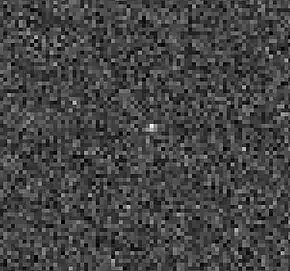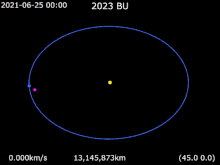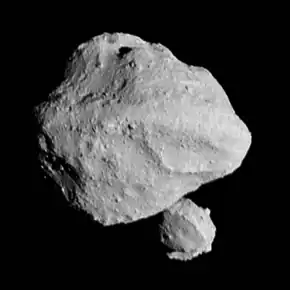 Radar image of 2023 BU by the Goldstone Solar System Radar on 29 January 2023 | |
| Discovery[1][2] | |
|---|---|
| Discovered by | Gennadiy Borisov |
| Discovery site | MARGO, Nauchnyi, Crimea |
| Discovery date | 21 January 2023 |
| Designations | |
| 2023 BU | |
| gb00553 | |
| NEO · Apollo | |
| Orbital characteristics[3] | |
| Epoch 25 February 2023 (JD 2460000.5) (Post-flyby orbit) | |
| Uncertainty parameter 1 | |
| Observation arc | 10 days (231 obs)[3] |
| Aphelion | 1.230 AU |
| Perihelion | 0.9840 AU |
| 1.107 AU | |
| Eccentricity | 0.1111 |
| 1.16 yr | |
| 28.7° | |
| Inclination | 3.75° |
| 125.5° | |
| 27 January 2023 04:30[4] | |
| 355.8° | |
| Earth MOID | 0.00046 AU (69,000 km; 0.18 LD) |
| Physical characteristics | |
Mean diameter | 3–8 meters (CNEOS)[5] |
| ~77 seconds[6] | |
| 29.4±0.5 (JPL)[3] 29.4 (MPC)[1] | |
2023 BU is a near-Earth object that passed 9,967 ± 1 km (6,193.21 ± 0.62 mi) from the centerpoint of Earth around 27 January 2023 00:29 UT.[3] Since Earth's radius is about 6,378 km (3,963 mi), it was expected to pass approximately 3,589 ± 1 km (2,230.10 ± 0.62 mi) from the surface of Earth over the southern tip of South America.[7] It passed at an altitude above low Earth orbit which is 2,000 km (1,200 mi) and below geostationary orbit which is 36,000 km (22,000 mi). The asteroid is about 3–8 meters in diameter[5] and approached Earth from the night sky. It is the fourth closest non-impacting approach known to Earth (excluding Earthgrazers) after 2020 VT4, 2020 QG, and 2021 UA1.
Orbital details

The asteroid came to perihelion (closest approach to the Sun) on 27 January 2023,[4] four hours after closest approach with Earth. 2023 BU was first imaged by Gennadiy Borisov at Nauchnyi, Crimea, on 21 January 2023 23:53 UT,[2] about five days before closest approach. It was last observed on 31 January 2023.[1]
| Date and time of closest approach | Earth distance (AU) |
Sun distance (AU) |
Velocity wrt Earth (km/s) |
Velocity wrt Sun (km/s) |
Uncertainty region (3-sigma) |
Reference |
|---|---|---|---|---|---|---|
| 2023-01-27 00:29 | 0.000067 AU (10,000 km; 0.0261 LD) | 0.985 AU (147.4 million km; 383 LD) | 9.3 | 35.2 | ± <1 km | Horizons |
The gravitational effect of the 2023 Earth approach will increase the orbital period from 359 days to an estimated 425 days.[8] It will lift the perihelion and aphelion distances. The relatively low Earth encounter speed of 9.3 km/s (21,000 mph) is a result of a low eccentricity and Earth-like orbit.
| Parameter | Epoch | Period (p) |
Aphelion (Q) |
Perihelion (q) |
Semi-major axis (a) |
Eccentricity (e) |
Inclination (i) |
|---|---|---|---|---|---|---|---|
| Units | (days) | AU | (°) | ||||
| Pre-flyby | 2022-Oct-25[8] | 358.9 | 1.05 | 0.926 | 0.988 | 0.063 | 2.35° |
| Post-flyby | 2023-Feb-25[3] | 425.4 | 1.23 | 0.984 | 1.11 | 0.111 | 3.75° |
Impact assessment
There was no risk of an Earth impact during the 2023 Earth approach. Assuming the asteroid is at the larger size estimate of 8 meters in diameter, if it had entered the atmosphere it would not have reached the ground intact and would breakup around 30 km above the ground, thus representing only minimal threat to life.[9]
Impacts by objects 8 meters (26 ft) in diameter occur, on average, every 5 years; impacts by objects 4 meters (13 ft) in diameter happen, on average, once every year.[9] 2023 BU has a 1 in 17 million chance of impacting Earth on 20 January 2110.[10]
| JPL SBDB solution |
Observation arc | Date and time of closest approach | Uncertainty region (3-sigma)[lower-alpha 1] |
|---|---|---|---|
| JPL 1 | 1 day (25 obs) | 2023-01-26 21:17 ± 02:22[11] | ± 2,600 km[12] |
| JPL 2 | 2 days (30 obs) | 2023-01-27 00:17 ± 01:05[13] | ± 1,700 km[14] |
| JPL 3 | 3 days (42 obs) | 2023-01-27 00:28 ± 00:10[15] | ± 262 km[16] |
| JPL 4 | 3 days (39 obs) | 2023-01-27 00:26 ± 00:10[17] | ± 260 km[18] |
| JPL 5 | 4 days (65 obs) | 2023-01-27 00:28 ± 00:02[19] | ± 29 km[20] |
| JPL 6 | 4 days (61 obs) | 2023-01-27 00:28 ± 00:02[21] | ± 27 km[22] |
| JPL 9 | 5 days (121 obs) | 2023-01-27 00:29 ± <00:01 | ± 5 km[23] |
| JPL 11 | 5 days (143 obs) | 2023-01-27 00:29 ± <00:01[24] | ± 2 km[25][lower-alpha 2] |
| JPL 12 | 6 days (166 obs) | 2023-01-27 00:29 ± <00:01[5] | ± 0.3 km[26] |
| JPL 13 | 6 days (191 obs) | 2023-01-27 00:29 ± <00:01 | ± 0.2 km[27] |
| JPL 14 | 6 days (194 obs) | 2023-01-27 00:29 ± <00:01 | ± 0.19 km[28] |
| JPL 15 | 6 days (199 obs) | 2023-01-27 00:29 ± <00:01 | ± 0.18 km[29] |
| JPL 19 | 10 days (231 obs) | 2023-01-27 00:29 ± <00:01 | ± 0.15 km[30] |
| JPL 21 | 10 days (238 obs) | 2023-01-27 00:29 ± <00:01 | ± 0.13 km[31] |
| Asteroid | Date | Distance from surface of Earth |
Uncertainty in approach distance |
Observation arc | Reference |
|---|---|---|---|---|---|
| 2020 VT4 | 2020-11-13 17:21 | 368 km | ±11 km | 5 days (34 obs) | data |
| 2020 QG | 2020-08-16 04:09 | 2939 km | ±11 km | 2 days (35 obs) | data |
| 2021 UA1 | 2021-10-25 03:07 | 3049 km | ±10 km | 1 day (22 obs) | data |
| 2023 BU | 2023-01-27 00:29 | 3589 km | ±<1 km | 10 days (231 obs) | data |
| 2011 CQ1 | 2011-02-04 19:39 | 5474 km | ±5 km | 1 day (35 obs) | data |
| 2019 UN13 | 2019-10-31 14:45 | 6235 km | ±189 km | 1 day (16 obs) | data |
| 2008 TS26 | 2008-10-09 03:30 | 6260 km | ±970 km | 1 day (19 obs) | data |
| 2004 FU162 | 2004-03-31 15:35 | 6535 km | ±13000 km | 1 day (4 obs) | data |
See also
Notes
- ↑ The JPL SBDB time of closest approach can vary by a minute from the Horizons time of closest approach giving them slightly different uncertainty regions. Horizons values are calculated using the JPL SBDB time of closest approach.
- ↑ JPL#11 Soln.date: 2023-Jan-26_15:02:34 PST was the active solution at the time of closest approach "2023-Jan-26 16:29 PST".
References
- 1 2 3 "2023 BU". Minor Planet Center. Retrieved 28 January 2023.
- 1 2 "MPEC 2023-B72 : 2023 BU". Minor Planet Electronic Circular. Minor Planet Center. 22 January 2023. Retrieved 22 January 2023.
- 1 2 3 4 5 6 "JPL Small-Body Database Browser: (2023 BU)". Jet Propulsion Laboratory. Archived from the original on 22 January 2023. Retrieved 28 January 2023.
- 1 2 "Perihelion @ 0.984AU on 27 Jan 2023" (Perihelion occurs when rdot flips from negative to positive). JPL Horizons. Retrieved 26 January 2023.
- 1 2 3 Archive JPL 12 CNEOS Close Approaches
- ↑ Northolt Branch Observatory: 77 seconds with an amplitude of 0.9 mag
- ↑ "NASA System Predicts Small Asteroid to Pass Close by Earth This Week". Jet Propulsion Laboratory. 25 January 2023. Retrieved 26 January 2023.
- 1 2 "Horizons Batch showing epoch 2022-Oct-25 and 2023-Feb-25". JPL Horizons. Retrieved 24 January 2023.
- 1 2 Robert Marcus; H. Jay Melosh; Gareth Collins. "Earth Impact Effects Program". Imperial College London / Purdue University. Retrieved 24 January 2023. (using 8-meter diameter, density of 3000 kg/m3, speed of 11.4 km/s, and impact angle of 45°)
- ↑ "Earth Impact Risk Summary: 2023 BU". NASA/JPL Near-Earth Object Program Office. Retrieved 11 February 2023.
- ↑ Archive JPL 1 SBDB
- ↑ Archive JPL 1 Horizons
- ↑ Archive JPL 2 CNEOS Close Approaches
- ↑ Archive JPL 2 Horizons
- ↑ Archive JPL 3 CNEOS Close Approaches
- ↑ Archive JPL 3 Horizons
- ↑ Archive JPL 4 CNEOS Close Approaches
- ↑ Archive JPL 4 Horizons
- ↑ Archive JPL 5 CNEOS Close Approaches
- ↑ Archive JPL 5 Horizons
- ↑ Archive JPL 6 CNEOS Close Approaches
- ↑ Archive JPL 6 Horizons
- ↑ Archive JPL 9 Horizons
- ↑ Archive JPL 11 CNEOS Close Approaches
- ↑ Archive JPL 11 Horizons
- ↑ Archive JPL 12 Horizons
- ↑ Archive JPL 13 Horizons
- ↑ Archive JPL 14 Horizons
- ↑ Archive JPL 15 Horizons
- ↑ Archive JPL 19 Horizons
- ↑ Archive JPL 21 Horizons
External links
- 2023 BU at NeoDyS-2, Near Earth Objects—Dynamic Site
- 2023 BU at ESA–space situational awareness
- 2023 BU at the JPL Small-Body Database
- Archived Scout entry
.png.webp)
